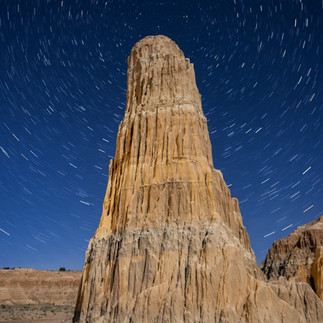Jared Tamez: Star and Stone
- Esther Candari
- Jun 8, 2024
- 2 min read
March 3rd - March 25th, 2023
Over the last few years I have been fascinated by long photographic exposures of the night sky and the interplay of the stars with desert landscapes. This series, Star and Stone, is meant to be a meditation on the long duration of celestial and earthly cycles of change and constancy.
Among the different genres of astrophotography, star trail photography is perhaps the most accessible and diverse. This style involves taking a single, long exposure or stacking multiple exposures of the stars to show the star’s motion in the sky over time. Because of the curvature of the earth and its rotation, the pathway of the stars appears to bow north and south, forming concentric circles at the poles (Star and Stone 3: Tower of Babel being one example at the north pole), straight lines at the celestial equator, and curved lines between. These star paths are comparable to the shape of the lines of latitude on a globe. Star and Stone 4: Turret Arch, for example, depicts the range of these lines. These celestial patterns provide a rich opportunity for artistic composition when coupled with terrestrial formations.On earth, in the foreground of these images, we see the culmination of millions of years of natural processes in any given moment. Because of the extended nature of the timeline, these rock formations appear fixed and constant when in reality largely imperceptible changes are constantly under way as erosion continues its work.
Similarly, when we glance at the night sky, we see a field of stars that appears static at any given moment, but which is constantly in motion throughout the night and shifting position from one night to the next, again, almost imperceptibly.
These star trail photographs bring these earthly and celestial time frames together and compress them at a glance in Star and Stone.
























Comments